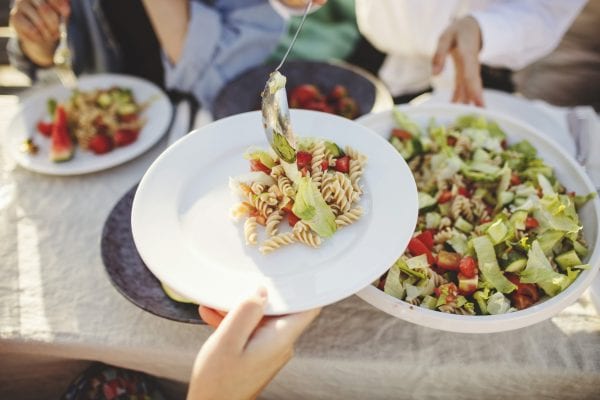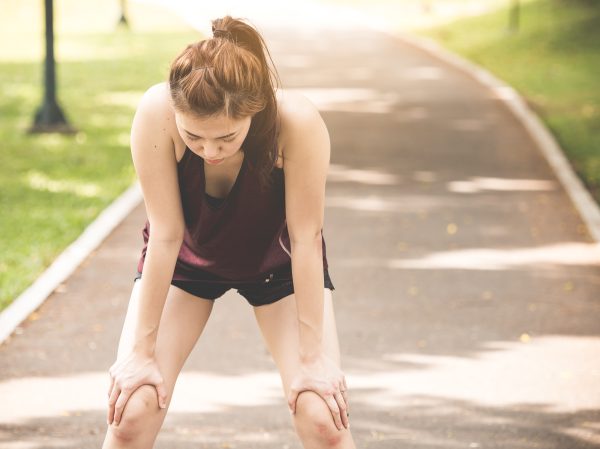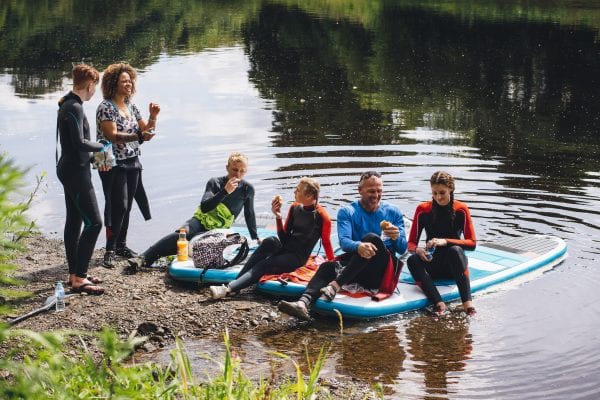Home & Family

Food consumed before and between athletic events can have a significant impact on an individual’s ability to perform.
Many people have their own ideas about what foods to consume around athletic events. Some of these ideas may be good. However, many foods consumed by athletes before and between events are inappropriate and may harm the athlete’s performance. This publication outlines the proper aspects of eating close to performance time.
A basic understanding of certain bodily functions can be helpful in learning the important components of a good pre-event meal.
Digestion
Athletic performance will be better if virtually no food is in the stomach or small intestines at the time the event is being performed. All food must be digested in the stomach and small intestines before being absorbed into the body and, thus, clear the gastrointestinal tract. However, the time needed for digestion varies due to factors such as the carbohydrate, fat, and protein content of the meal as well as the size of the meal. For example, carbohydrates are relatively easy to digest. Carbohydrates can generally be digested and absorbed in about three to four hours.
Fat and protein, however, require a much longer time, approximately five to seven hours, to digest and absorb. The size of the meal also can influence the overall time needed for digestion and absorption. Large meals may require many hours to clear the gastrointestinal tract, whereas, smaller meals may be digested in just a couple of hours.
Nervousness often associated with athletic events can also impair normal digestion and absorption of food.
Blood Supply
An average-size adult will have about five quarts of blood circulating throughout the body. Children have less, the amount depending on the size of the child. Following ingestion of a meal, blood will be diverted from areas of the body with low needs to the stomach and intestinal area. This extra blood helps the processes of digestion and absorption of the food that has been eaten. During exercise, large amounts of blood are diverted to the working muscles and to the skin for sweat production and cooling. In this process, blood is actually shunted away from the gastrointestinal tract. Thus, digestion and absorption of food can be impaired during exercise because the digestive system receives less blood instead of more. Therefore, it is advantageous to the athlete to have the digestive and absorptive processes virtually complete by the time exercise starts. There should be little or no food in the stomach and small intestine at the time of exercise.
Liver Carbohydrate
 The liver is capable of storing carbohydrate (called glycogen). This liver carbohydrate can be released to the blood and is a major source of blood glucose (blood sugar). If the blood glucose concentration drops too low, working muscle and brain, which rely on the glucose for energy, can be deprived of this fuel source and not function properly. This would be detrimental to the person who is exercising. The liver can store enough carbohydrate to supply the brain and resting muscles for about 12 to 15 hours. Working muscle will use up liver carbohydrate much faster. Thus, making sure liver carbohydrate stores are at maximum levels would be important for an athlete about to enter an event.
The liver is capable of storing carbohydrate (called glycogen). This liver carbohydrate can be released to the blood and is a major source of blood glucose (blood sugar). If the blood glucose concentration drops too low, working muscle and brain, which rely on the glucose for energy, can be deprived of this fuel source and not function properly. This would be detrimental to the person who is exercising. The liver can store enough carbohydrate to supply the brain and resting muscles for about 12 to 15 hours. Working muscle will use up liver carbohydrate much faster. Thus, making sure liver carbohydrate stores are at maximum levels would be important for an athlete about to enter an event.
Components of a Good Pre-event Meal
Certain components of a proper pre-event meal can be important to performance. The meal should clear the gastrointestinal tract by the time the event starts. The meal should be able to enhance liver carbohydrate stores, and the meal should help support hydration in the athlete.
Basic guidelines for proper pre-event meals have been developed. These are summarized in table 1 and discussed in more detail in the following paragraphs.
Table 1. Components of a Good Pre-event Meal
| Components of a Good Pre-event Meal |
|---|
| The meal should be consumed 2 to 4 hours before the event. |
| The meal should be high in carbohydrate content with small amounts of fat and protein. |
| Generally, foods should be somewhat bland. Spicy, gas-producing, and other irritating foods should be avoided. |
| The meal should be low in dietary fiber. |
| The meal should be small in size— less than 1,000 calories. |
| Diluted, caffeine-free drinks should be consumed. Alcoholic beverages should be avoided. |
Timing
 Because virtually all food should be cleared from the gastrointestinal tract before exercise, timing of the meal becomes an important issue. Pre-event meals should be consumed from 2 to 4 hours before exercise. This allows ample time for a proper pre-event meal to be cleared. If the meal is consumed longer than 4 hours before the event, then the athlete may become hungry. Foods eaten less than 2 hours before exercise may not have time to be digested and absorbed. This can actually hurt performance.
Because virtually all food should be cleared from the gastrointestinal tract before exercise, timing of the meal becomes an important issue. Pre-event meals should be consumed from 2 to 4 hours before exercise. This allows ample time for a proper pre-event meal to be cleared. If the meal is consumed longer than 4 hours before the event, then the athlete may become hungry. Foods eaten less than 2 hours before exercise may not have time to be digested and absorbed. This can actually hurt performance.
Composition of the meal
Carbohydrate foods clear the stomach and small intestines faster than high protein or high fat foods. Thus, pre-event meals should consist primarily of high carbohydrate–type foods. Small amounts of protein and fat are acceptable. Examples of good high carbohydrate foods to be used in pre-event nutrition can be found in table 2. Items such as breads, cereals, pasta, pancakes, rice, fruits and fruit juices and low fat yogurt are all examples of foods that could be used in a pre-event meal. Foods such as steaks, eggs, french fries, hamburgers, hot dogs, nuts, and bacon are high in fat or protein and should be minimized in meals eaten before competition.
Table 2. Pre-event High Carbohydrate Foods
| Pre-event High Carbohydrate Foods |
|---|
| Toast and jelly |
| Spaghetti with tomato sauce |
| Bread |
| Macaroni |
| Low fat yogurt |
| Sherbet |
| Skim milk |
| Pancakes with syrup |
| Bagels |
| Low fiber cereals |
| Thick-crust cheese pizza |
| Rice |
| Baked potato |
| Canned fruit |
| Puddings |
| Applesauce |
| Bananas |
| Grits |
| Fruit juices |
| Waffles |
| Cream of Wheat |
| English muffins |
Bland foods
Foods eaten before competition generally should be somewhat bland in taste. Spicy foods with pepper or chili powder and foods such as onions, cabbage, broccoli, and beans should be avoided. These foods tend to stimulate the gastrointestinal tract, produce gas, and could cause problems when eaten before athletic events. While a small amount of carbonated beverage is probably acceptable, consumption of large quantities of these beverages should be avoided due to possible gas production.
Dietary fiber
Normally, it would be a good practice to include foods with ample dietary fiber in one’s diet. However, some types of dietary fiber can stimulate defecation, and having to go to the bathroom during an athletic event is not advantageous. Foods high in fiber, such as beans, various types of bran, nuts, and raw vegetables, should be minimized during the hours or day before a major competition.
Meal size
As previously mentioned, large meals take a long time to be digested and absorbed. Large meals eaten the day before an athletic event would be acceptable; however, large meals should not be consumed on the day of an event, before the competition. Consumption of large pre-event meals will virtually guarantee that food will still be in the stomach and small intestines at the time of competition. This can cause minor to serious discomfort for the athlete. It is recommended that pre-event meals not exceed 1,000 calories. Often the meal may be only 500 to 600 calories. For example, a turkey sandwich made with white bread, mustard, and a small amount of lettuce and tomato would contain approximately 350 calories. Add a glass of apple juice (120 calories) and a cup of flavored yogurt (220 calories) and you have a pre-event meal of almost 700 calories. A breakfast of two 6-inch pancakes (200 calories), 2 pats of margarine (90 calories), 4 ounces of syrup (100 calories), and an 8-ounce glass of orange juice (120 calories) would provide a total of 510 calories.
Beverages
The consumption of ample quantities of fluid in the hours before competition is encouraged. This will ensure that the athlete does not go into the event in a dehydrated state. Beverages such as low fat or skim milk or fruit juices can be consumed up 2 hours before the event. Water and sports drinks should be consumed 2 hours or less before the start of the event. Consumption of carbonated beverages should be minimized in the pre-event period as these types of beverages may result in excessive belching and stomach discomfort before exercise.
Consumption of caffeine-containing beverages, such as coffee, tea, and cola, should also be avoided during this time. Caffeine has a diuretic action that can increase urine output and possibly contribute to dehydration. Caffeine consumption can also increase the frequency of defecation. Alcoholic beverages should be avoided. Alcohol has a diuretic action similar to caffeine. In addition, alcohol consumption beyond minimal amounts can have adverse effects on performance.
Adverse Effects of Improper Pre-event Meals
 Improper pre-event nutrition can harm the athlete in several ways. These are outlined in table 3. If meals before competition are taken too far in advance or are low in carbohydrates, then the athlete could go into the event feeling hungry and perhaps with blood sugar values that are lower than optimum. Low fluid consumption in the hours before an event can result in the athlete’s being dehydrated. This would adversely influence performance, especially on hot, humid days.
Improper pre-event nutrition can harm the athlete in several ways. These are outlined in table 3. If meals before competition are taken too far in advance or are low in carbohydrates, then the athlete could go into the event feeling hungry and perhaps with blood sugar values that are lower than optimum. Low fluid consumption in the hours before an event can result in the athlete’s being dehydrated. This would adversely influence performance, especially on hot, humid days.
Most adverse effects of pre-event meals are associated with food still remaining in the stomach and intestines when physical activity begins. This food can cause numerous gastrointestinal problems as outlined in table 3. All of these side effects could cause the athlete to perform less than optimally. Even if symptoms are not severe, the athlete’s performance is probably being compromised.
Table 3. Adverse Symptoms of an Improper Pre-event Meal
| Adverse Symptoms of an Improper Pre-event Meal |
|---|
| Nausea |
| Vomiting |
| Intestinal cramps |
| Flatulence |
| Belching |
| Diarrhea or the urge to defecate |
| Low blood sugar |
| Dehydration |
Eating Between Events
 Many athletes may have to perform several times during a day. Multiple matches in tennis and two or three soccer games in a day are not unusual. Guidelines for eating between these events generally are not different from those previously discussed for pre-event meals. This is especially true if there are at least 2 hours between events. The between-events meal then becomes a pre-event meal. Often the time between events is less than 2 hours. In these cases a full meal cannot be consumed. Instead, a small, high-carbohydrate snack will need to be consumed along with adequate fluid intake from sports drinks and water. Examples of high carbohydrate snack foods can be found in table 4. Generally, in these situations the athlete would not want to consume more than about 300 calories. The main focus is to keep the athlete hydrated and not feeling hungry, yet still leave the gastrointestinal tract empty when competition begins.
Many athletes may have to perform several times during a day. Multiple matches in tennis and two or three soccer games in a day are not unusual. Guidelines for eating between these events generally are not different from those previously discussed for pre-event meals. This is especially true if there are at least 2 hours between events. The between-events meal then becomes a pre-event meal. Often the time between events is less than 2 hours. In these cases a full meal cannot be consumed. Instead, a small, high-carbohydrate snack will need to be consumed along with adequate fluid intake from sports drinks and water. Examples of high carbohydrate snack foods can be found in table 4. Generally, in these situations the athlete would not want to consume more than about 300 calories. The main focus is to keep the athlete hydrated and not feeling hungry, yet still leave the gastrointestinal tract empty when competition begins.
Eating in Restaurants
If possible, it is probably best to eat pre-event meals at home and to bring between-events snacks with you the day of the event. This allows better control by the athlete of food choices, volume, timing, etc. However, eating foods from or at home is not always possible and athletes must choose foods from restaurant menus. As much as possible, the same guidelines should be followed when eating out (timing, composition, and size of meal). Most restaurants will offer some lower fat foods. For example, choose a grilled chicken sandwich with honey mustard instead of a hamburger with mayonnaise and cheese. Choose orange juice or water instead of a carbonated drink. If eating Mexican food, choose a basic bean burrito without sour cream and cheese. If eating Italian, spaghetti with just a tomato sauce would be better than a spicy meat sauce. A thick- crust cheese and mushroom pizza would be better than a thin-crust pepperoni, sausage, and peppers pizza. In a Chinese restaurant, eat mostly rice with just a little of the other dishes. These are just a few examples of proper pre-event menu choices in various restaurants. With a little knowledge and forethought, choosing good pre-event meals from restaurants can be accomplished.
Table 4. Between-Events Snack Foods
| Between-Events Snack Foods |
|---|
| Oatmeal raisin cookies |
| Fig/Apple/Strawberry Newtons |
| Graham crackers |
| Saltine crackers |
| Pretzels |
| Low fat yogurt |
| Animal crackers |
| Raisins |
| Bread |
| Bananas |
| Canned peaches |
| Applesauce |
| Low fat puddings |
| Pop-Tarts |
| Vanilla wafers |
| Sports drinks |
Revised by Helen H. Jones, Regional Extension Agent, Christina Levert, Regional Extension Agent, and Sheree Taylor, Regional Extension Agent, all with Auburn University. Written by Robert E. Keith, former Extension Specialist.
Reviewed July 2022, Eat to Compete: Sports Nutrition for Young Adults— Eating Before & Between Athletic Events, HE-0750

